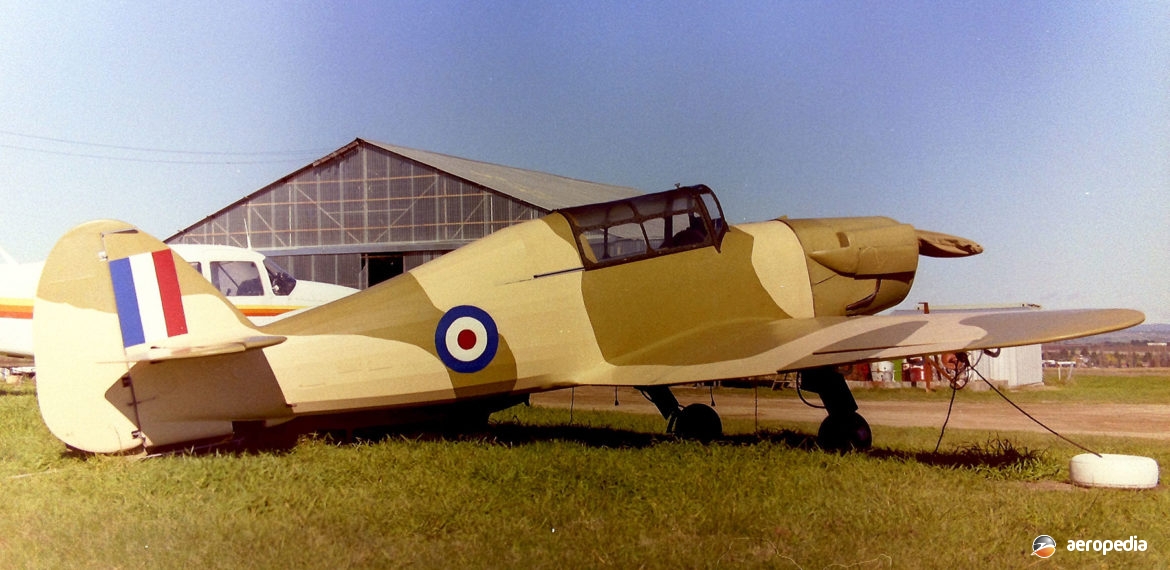Photograph:
Sindlinger HH-1 Hawker Hurricane VH-LKY (c/n N171) at Bathurst, NSW in 1989 (David C Eyre)
Country of origin:
United States of America
Description:
Single-seat light sport monoplane
Power Plant:
One 112 kw (150 hp) Lycoming O-320-A2B four-cylinder horizontally-opposed air-cooled engine
Specifications:
- Wingspan: 7.62 m (25 ft 1 in)
- Length: 5.99 m (19 ft 8 in)
- Height: 1.78 m (5 ft 10 in)
- Wing area: 9.38 m² (101 sq ft)
- Max speed at sea level: 322 km/h (200 mph)
- Max cruising speed at 65% power at 1,830 m (6,000 ft): 265 km/h (165 mph)
- Max rate of climb at sea level: 564 m/min (1,850 ft/min)
- Stalling speed: 100 km/h (62 mph)
- Max range with no fuel reserves: 1,005 km (625 miles)
- Empty weight: 456 kg (1,005 lb)
- Loaded weight: 624 kg (1,375 lb)
History:
The HH-1 Hawker Hurricane was designed by Fred G Sindlinger in Washington as a ⅝-scale replica of the famous Battle of Britain fighter of World War II, being aimed at representing a scale version of the Hurricane IIc. Construction of a prototype (N33000 – c/n HH-1) began in mid 1969, the first flight of this machine taking place in January 1972, and FAA certification in the Experimental category being granted in May 1972. In September 1973 plans were made available to amateur constructors. By 1979 fifty sets of drawings had been sold and about 20 were under construction. First aircraft to be completed from plans flew in South Africa in 1978.
Of wooden construction using Sitka spruce and plywood and fabric covering, the type has proved popular with warbird enthusiasts who cannot afford the real thing (and which is not available anyway). From 1973 plans and certain components were made available to amateur constructors, examples being built in Africa, Germany, the USA and the United Kingdom. The first of the type seen in this area arrived in late 1986. The type was stressed to +6 G; fuel capacity was 106 litres (23.3 Imp gals), and baggage capacity was 18 kg (40 lb). At the 1972 EAA Oshkosh Fly-in at Wisconsin the prototype received two awards: Best Replica and Best Landing Gear Design. The main undercarriage is retractable, actuation usually being by hand crank.
Two examples have been registered in Australia, the first being VH-LKY (c/n N171) at Cowra, NSW. It was first registered on 1 July 1991 but suffered damage in an accident on 18 December 1998. It was rebuilt and was later placed on the RAA register as 19-3105.
The second became VH-AFW (c/n W140) at Perth, WA. This latter machine was built by Arthur Winstanley. He studied at the de Havilland Technical School in the United Kingdom, later becoming an engineer with British Overseas Airways Corp (BOAC) and was flying Comet Is and IVs, Constellations, Super Constellations, Vickers VC-10s and later the Concorde. He retired in 1981 and commenced the construction of the Hurricane in September 1982 in England, which took ten years and 7,500 hours. It made its first flight on 17 March 1993. He moved to Australia from York, took up residence in Perth but died in January 1998. The aircraft was presented by his widow to the Aviation History Museum at Bull Creek, Perth and, painted in the colours of 607 Squadron RAF, it has been placed alongside a full-size Supermarine Spitfire and an Avro Lancaster.
Examples have been completed in New Zealand. One machine ZK-VYX (ex ZK-FVW) was obtained partially completed by Robert Gibson. It was fitted with a Mitsubishi 3-litre V-6 converted motor car engine producing 119 kw (160 hp). It was based at the Taieri Aero Club at Dunedin. Another was to become ZK-III (c/n AACA/635/2) and was to be registered in July 1990 but the registration was not taken up and it became ZK-FVW but was eventually withdrawn from service at Blenheim.

